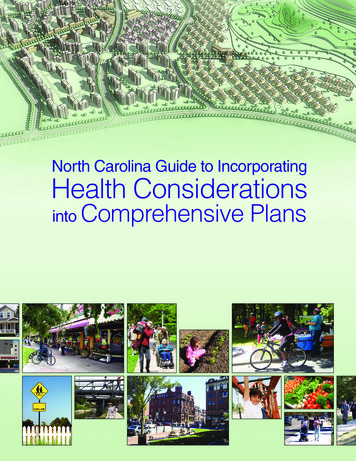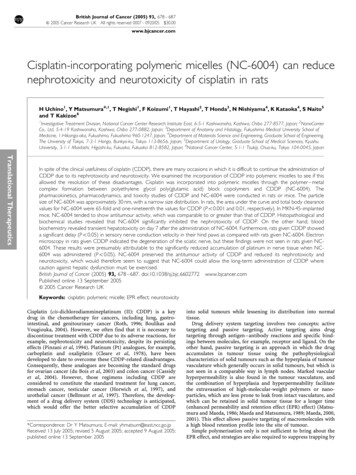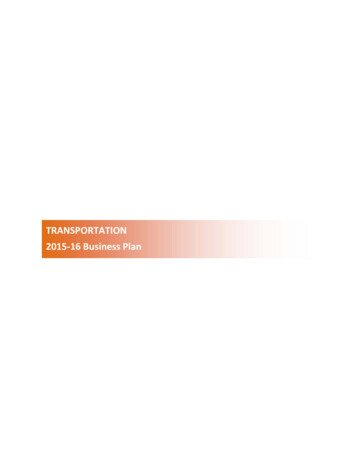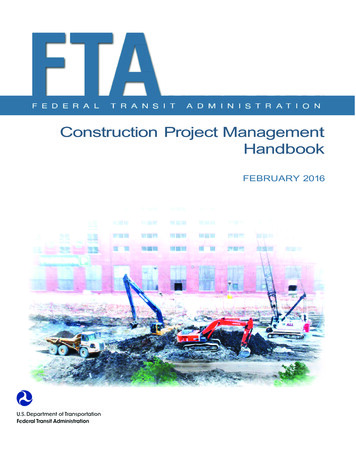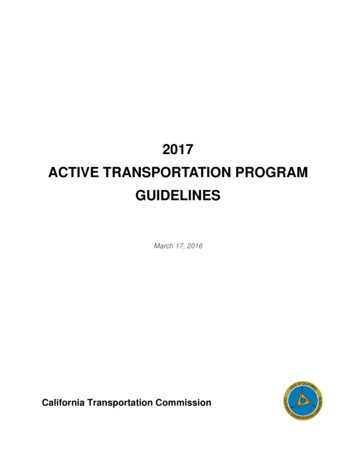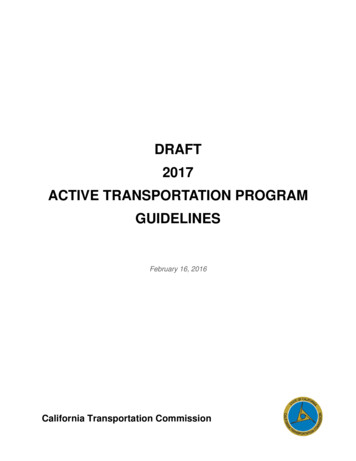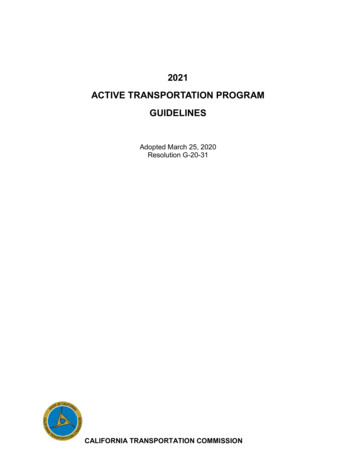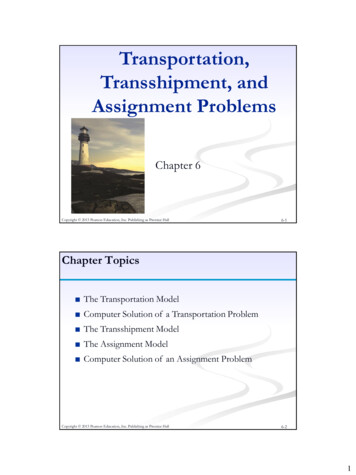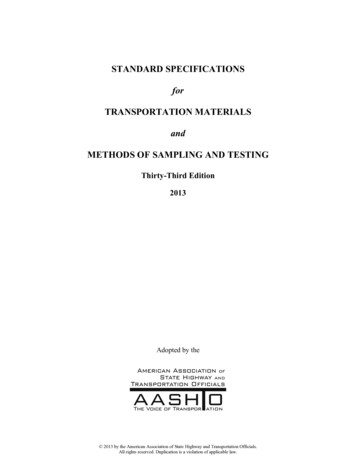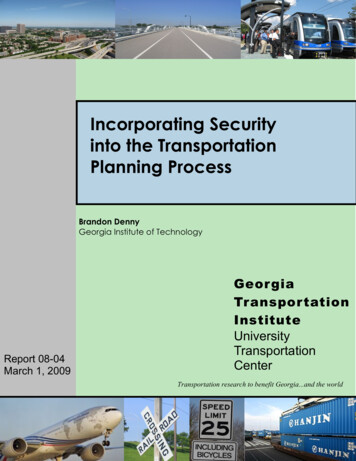
Transcription
Incorporating Securityinto the TransportationPlanning ProcessBrandon DennyGeorgia Institute of TechnologyReport 08-04March 1, 2009GeorgiaTranspor portation research to benefit Georgia.and the world
1. Report No.2. Government Accession No.Technical Report Documentation Page3. Recipient’s Catalog No.GTI-08-044. Title and Subtitle5. Report DateIncorporating Security into the Transportation Planning ProcessMarch 1, 20096. Performing Organization CodeGTI/UTC7. Author(s)8. Performing Organization Report No.Brandon Denny08-049. Performing Organization Name and Address10. Work Unit No. (TRAIS)Georgia Transportation Institute/UTCGeorgia Institute of Technology790 Atlantic DriveAtlanta, GA 30332-035511. Contract or Grant No.12. Sponsoring Agency Name and Address13. Type of Report and Period CoveredGeorgia Transportation Institute/UTCGeorgia Institute of Technology790 Atlantic DriveAtlanta, GA 30332-0355Research Report, 2008-200914. Sponsoring Agency Code15. Supplementary NotesThis research is partly supported by the University of Tennessee’s Southern Transportation Center.16. AbstractThe transportation system is an important network established to ensure the mobility of people and goods betweendestinations. In addition, it also serves a vital role in responding to disasters, and therefore deserves special attention whenthose disasters threaten to decrease its support capability. The task of securing a transportation system consisting ofmultiple interconnected assets is a complex responsibility. As an owner and operator of major transportationinfrastructure, state Departments of Transportation (DOTs) have a vested interest in ensuring this balance and represent animportant mediator between federal and local interests, assuming nine key security planning roles in their traditionaltransportation planning duties: Coordinator, Analyzer/Planner, Financial Administrator, Infrastructure Owner,Infrastructure Operator, Implementer, Regulator, Information Provider, and Influencer.Through their internal vulnerability assessments, the departments already perform a vital security planning functionthat can support their own planning efforts as well as others. Incorporating security into the transportation planningprocess requires modification as feedback of implementation methods is received. It does not mean transforming the DOTinto a security agency, but rather incorporating a security perspective into the analysis of the system. This first involvesestablishing a more solid role as a coordinator in order to solidify vital linkages between agencies relevant to securityplanning. This interaction should reveal standardization issues the DOT can address in order to ensure effectivecollaboration, communication and coordination. Funding security measures may be difficult; but by incorporating securitymeasures into initial analyzation and planning processes, they can be brought into the broader concept of the system ratherthan simply added as additional funding needs. The nine roles suggested earlier offer opportunities for state DOTs toovercome these and other challenges faced in the process of incorporating security into the transportation planningprocess. Through these roles, state DOTs can ensure that security efforts reach the parts of the system that require themand begin to build a more secure system.17. Key Words18. Distribution StatementTransportation, Department of Transportation, TransportationSecurity, Vulnerability AssessmentNo restrictions.19. Security Classif (of this report)20. Security Classif (of this page)21. No. of PagesUnclassifiedUnclassified55Form DOT F 1700.7 (8-72)Reproduction of completed page authorized22. Price
TABLE OF CONTENTSLIST OF TABLES . iiiLIST OF FIGURES . ivLIST OF ABBREVIATIONS . vSUMMARY . viCHAPTER 1: INTRODUCTION . 1CHAPTER 2: CONCEPTUAL FRAMEWORK . 3CHAPTER 3: CHARACTERISTICS OF THE TRANSPORTATION SECURITYPLANNING ENVIRONMENT . 63.1 National DOT Security Planning . 73.2 State DOT Security Planning . 93.2.1 State Emergency Operations Plans . 93.2.2 Continuity of Operations Plans . 12CHAPTER 4: ASSESSING AND QUANTIFYING VULNERABILITY . 154.1 Vulnerability Analysis . 154.2 Critical Asset Identification . 164.2.1 Criticality assessment issues . 194.3 Vulnerability Assessment . 204.3.1 Vulnerability Assessment Issues. 224.4 Consequence Assessment . 234.5 Countermeasures . 25CHAPTER 5: ISSUES IN TRANSPORTATION SECURITY PLANNING . 265.1 Funding . 265.2 Coordination . 295.3 Standardization . 315.4 Communications Equipment Compatibility . 325.5 Role of Intelligent Transportation System . 33CHAPTER 6: CONCLUSIONS . 35CHAPTER 7: RECOMMENDATIONS. 37APPENDIX A: EMERGENCY SUPPORT FUNCTION #1 . 40APPENDIX B: INTERVIEW QUESTIONNAIRE. 50i
APPENDIX C: CRITICAL ASSET FACTORS . 51APPENDIX D: VULNERABILITY FACTORS. 52REFERENCES . 53ii
LIST OF TABLESTABLE 1: EXAMPLE CRITICALITY SCORING TABLE . 18TABLE 2: EXAMPLE CRITICAL ASSET FACTOR SCALE . 19TABLE 3: EXAMPLE VULNERABILITY SCORING TABLE . 22TABLE 4: FACTOR VALUES FOR RECOGNITION AND ATTENDANCE . 23TABLE 5: A SUMMARY OF STATE DOT ROLES. . 38iii
LIST OF FIGURESFIGURE 1: THE POSITION AND ROLES OF THE STATE DOT . 3FIGURE 2: VULNERABILITY VERSUS CRITICALITY AND THE FOURQUADRANTS OF CONSEQUENCE. . 24iv
LIST OF ABBREVIATIONSAASHTOAmerican Association of State Highway and TransportationOfficialsCOOPContinuity of Operations PlanCPTEDCrime Prevention Through Environmental DesignDHSDepartment of Homeland SecurityDOTDepartment of TransportationEMAEmergency Management AgencyEOPEmergency Operations PlanFEMAFederal Emergency Management AgencyGAOGeneral Accounting OfficeHARHighway Advisory RadioICSIncident Command SystemITSIntelligent Transportation SystemMPOMetropolitan Planning AgencyMTIMineta Transportation InstituteNCHRPNational Cooperative Highway Research ProgramNRP-CICatastrophic Incident National Response PlanOEMOffice of Emergency ManagementSAFETEA-LUSafe, Accountable, Flexible, Efficient Transportation Equity Act:A Legacy for UsersTCRPTransit Cooperative Research ProgramTEA-21Transportation Equity Act for the 21st Centuryv
SUMMARYThe transportation system is an important network established to ensure themobility of people and goods between destinations. In addition, it also serves a vital rolein responding to disasters, and therefore deserves special attention when those disastersthreaten to decrease its support capability. The importance of maintaining this capabilityis highlighted by the inclusion of transportation system security as a separate planningfactor in the 2005 Safe, Accountable, Flexible, Efficient Transportation Equity Act: ALegacy for Users legislation.Yet the task of securing a transportation system consisting of multipleinterconnecting assets is a difficult responsibility. It requires the ability to negotiate thebalance between mobility and security in cooperation with multiple stakeholders andinterests. It also faces important challenges such as coordinating the various interests andsources of information related to security planning, generating funding for securityimprovements or operations, and creating standards that ensure security plans exist oncompatible platforms.As an owner and operator of major transportation infrastructure, stateDepartments of Transportation (DOTs) have a vested interest in ensuring this balance andrepresent an important mediator between federal and local interests, assuming nine keysecurity planning roles in their traditional transportation planning duties: Coordinator,Analyzer/Planner, Financial Administrator, Infrastructure Owner, Infrastructure Operator,Implementer, Regulator, Information Provider, and Influencer. Through their internalvulnerability assessments, the departments already perform a vital security planningfunction that can support their own planning efforts as well as others.Incorporating security into the transportation planning process should be anongoing effort of the state DOT, requiring modification as feedback of implementationmethods is received. It does not mean transforming this transportation agency into asecurity agency, but rather incorporating a security perspective into the analysis of thesystem. This first involves establishing a more solid role as a coordinator in order tosolidify vital linkages between agencies relevant to security planning. This interactionshould reveal standardization issues the DOT can address in order to ensure effectivecollaboration, communication and coordination. Funding security measures may bedifficult; but by incorporating security measures into initial analyzation and planningprocesses, they can be brought into the broader concept of the system rather than simplyadded as additional funding needs. The nine roles suggested earlier offer opportunitiesfor state DOTs to overcome these and other challenges faced in the process ofincorporating security into the transportation planning process. Through these roles, stateDOTs can ensure that security efforts reach the parts of the system that require them andbegin to build a more secure system.vi
Chapter 1:IntroductionThe U.S. transportation system consists of multiple interconnected assetsincluding highways, transit systems, railroads, airports, waterways, pipelines and ports, aswell as the vehicles, aircraft, and vessels that interact with these assets.Interdependencies exist between the transportation system and nearly every other sectorof the economy, and it provides the backbone for maintaining important public works andgovernment functions. Consequently, maintaining the security of the system is essentialto America's continued economic prosperity because a threat to the transportation systemcan have a broad impact on everything it supports. Bridges alone currently account for apotential 10 billion impact from the loss of one of the 1000 bridges listed as critical tothe U.S. (1). However, enhancing security can adversely affect mobility. The post-9/11passenger aviation experience in the U.S. is one example of the delicate balance betweensecurity efforts and maintaining mobility, evidenced by the increase in total travel timeassociated with airport security checkpoints. Maintaining this balance is not an easy taskas it involves multiple stakeholders that may complicate and inhibit the security planningprocess. For instance, despite the relatively quick post-9/11 legislative action supportingtransportation security such as the USA Patriot Act and the Homeland Security Act,states are still facing funding issues for surface transportation security improvementsseveral years later (2).As an owner and operator of major transportation infrastructure, stateDepartments of Transportation (DOTs), have a vested interest in the continued operationof the transportation system as a whole (in contrast to a transit agency for example,whose primary focus is on the local transit system) and therefore are concerned with thesystem’s resilience to multiple types of threats. As a planner and implementer of systemcomponents such as Intelligent Transportation System (ITS) technologies and evacuationroute models, DOTs also possess the resources to evaluate and enhance the system.Although security planning cannot be left to a single agency due to its complexity, itseems that DOTs have the motivation and ability to unite the various security interestsinto a unified front; yet they currently do not.The purpose of this report is to examine the environment in which transportationsecurity planning currently exists at the level of the state DOT, as well as examine anyissues or barriers related to the implementation of an effective security assessment andcountermeasure program. This analysis involves determining the current as well aspossible roles state DOTs assume in relation to other agencies in order to identify wherethey can be most effective in the security analysis process. Because there is very littleexisting literature specifically addressing the role of state DOTs in the security planningprocess, this analysis is based on multiple sources addressing particular issues in securityplanning as well as interviews with security planning officials at selected state DOTs.Four roles have already been suggested (Owner, Operator, Planner, Implementer), and ananalysis of the issues will bring to light other possible roles, as well as allow forcomparison of these roles against each other.1
The following chapter introduces the conceptual framework that transportationsecurity planning will be examined in, establishing the position of state DOTs in relationto other agencies involved in the same endeavor. Chapter 3 discusses the complicationsinvolved in planning for disasters within the transportation environment, specificallyexamining established emergency response practices among both the U.S. DOT and stateDOTs, and their relationship with one another. Chapter 4 then moves to the pre-disasterphase, examining the process of assessing the vulnerability of critical transportationassets. Chapter 5 combines personal interviews of state DOT security planning personnelwith recent literature examining unresolved issues in security planning, and uses thisinformation to explore the opportunities for state DOTs to improve this planning throughthe roles presented in Chapter 2. Chapter 6 provides a summary analysis of these issues,with recommendations following in Chapter 7.It is important to note that although the term ―security‖ is used, this analysis is notspecifically focused on activities developed in response to criminal or terrorist events.Instead, ―security‖ is used here also in relation to the threat of environmental hazards andnatural occurrences, representing the degree to which the transportation system and itsoperators can effectively anticipate and respond to various disasters.2
Chapter 2:Conceptual FrameworkFigure 1 shows the relative position of state DOTs with respect to other agenciesinvolved in transportation security planning and emergency management, and definesnine roles the DOT can assume through its authority or function. The National ResponseFramework, which outlines the principles that guide federal and local agencies in aunified response to emergencies, identifies 38 different agencies involved in disasterresponse (3). However, this discussion is limited to the transportation environment, andtherefore is concerned specifically with state DOTs and the agencies it must coordinatewith during its planning process.Figure 1: The position and roles of the state DOTSource: AuthorThe federal government—through agencies such as the U.S. DOT, the FederalEmergency Management Agency (FEMA), and Department of Homeland Security(DHS)—oversees the three agencies directly involved in emergency response planningwithin the transportation environment (Emergency Management Agencies (EMAs), stateDepartments of Transportation, and law enforcement agencies), providing generalguidance through federal mandates in addition to serving as primary coordinators duringnational emergencies. In order to plan for their specific role in an emergency, the stateDOT needs to coordinate with the state EMA, which establishes the general system forcoordinating state response to disasters, and law enforcement agencies, whose securityknowledge and expertise helps inform the security planning process. In return, the stateDOT can provide critical information to these agencies, the federal government, and3
other agencies as to the characteristics of the transportation system during an emergency.In this manner, the state DOT is both influenced by and influences coordinating agenciesand federal agencies.Figure 1 also highlights in blue the nine roles state DOTs assume in ensuring theeffectiveness of the transportation system during a disaster. Through coordination withrelevant agencies and targeted use of its budget, the state DOT is able to plan andimplement strategies to protect its infrastructure and its users during and after a disaster.System analysis allows the DOT to obtain the information it needs to inform disasterresponse; and by regulating its infrastructure, the DOT is also able to influence the use oftransportation infrastructure in accordance with disaster plans. Although these roles mayappear hierarchical in the flow chart, in reality this is not the case. However, these rolescan be broken up into two categories. Five of these roles (Coordinator, Analyzer/Planner,Financial Administrator, and Infrastructure Owner/Operator) represent opportunities forthe DOT to change within its organization in order to more fluidly incorporate securityinto planning, while four of them (Implementer, Regulator, Information Provider, andInfluencer) define how those internal changes will be reflected in a more securetransportation system. A brief description of each role is presented below. A morethorough discussion of these two categories is presented in the analysis andrecommendations sections as they relate to the changing role of security in thetransportation planning process.Coordinator – in the process of serving the public interest and implementingstrategies to improve the state transportation sys
transportation security such as the USA Patriot Act and the Homeland Security Act, states are still facing funding issues for surface transportation security improvements several years later (2). As an owner and operator of major transportation infrastructure, state Departments of Transportation

